HEALT 2114 - Oral Health Disparities in Indigenous Australians
VerifiedAdded on 2022/10/15
|12
|1036
|8
Essay
AI Summary
This essay explores the critical issue of oral health disparities among Indigenous Australians, examining the prevalence of oral diseases like tooth decay and gum disease. It highlights the role of healthcare professionals in oral healthcare, including education, surveillance, and intervention strategies. The essay delves into barriers to oral healthcare, such as low socioeconomic status and lack of awareness. It analyzes current strategies like the Aboriginal Oral Health Program and discusses potential future strategies to improve the oral health of Indigenous Australians, emphasizing the need for long-term solutions and improved socioeconomic conditions. The essay uses current statistics and references relevant literature to support its findings and recommendations, aiming to address the existing health gap.
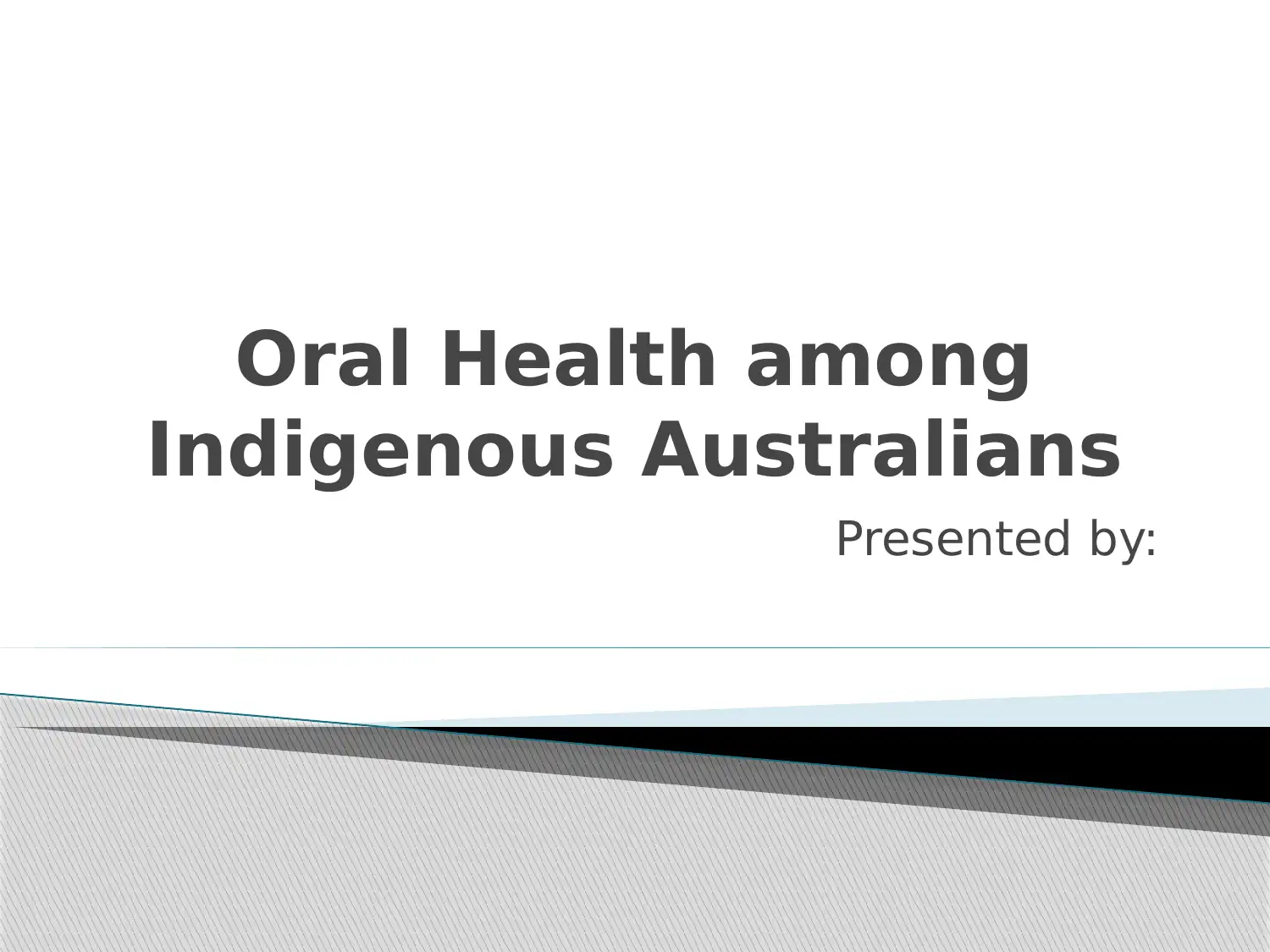
Oral Health among
Indigenous Australians
Presented by:
Indigenous Australians
Presented by:
Paraphrase This Document
Need a fresh take? Get an instant paraphrase of this document with our AI Paraphraser
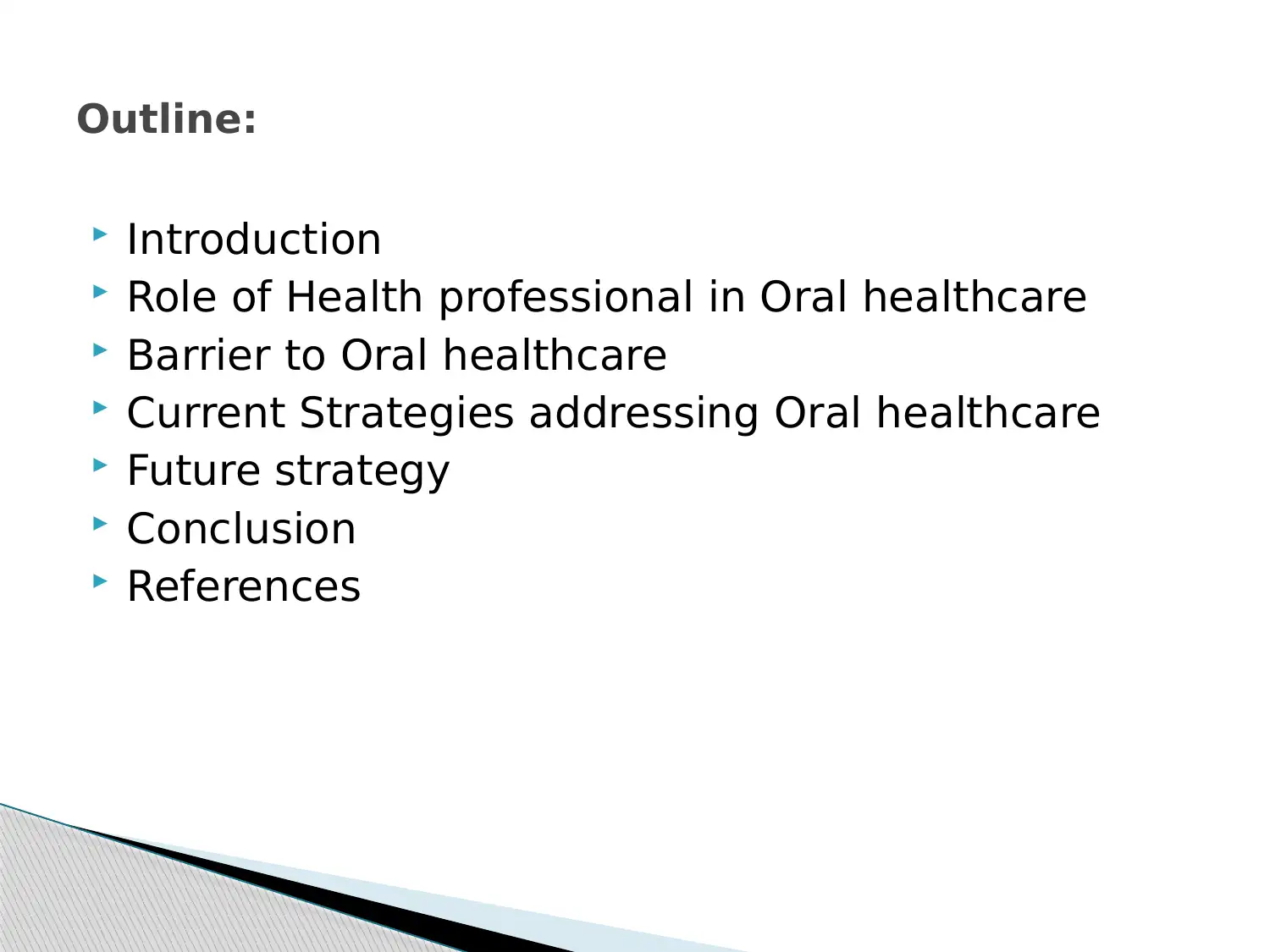
Introduction
Role of Health professional in Oral healthcare
Barrier to Oral healthcare
Current Strategies addressing Oral healthcare
Future strategy
Conclusion
References
Outline:
Role of Health professional in Oral healthcare
Barrier to Oral healthcare
Current Strategies addressing Oral healthcare
Future strategy
Conclusion
References
Outline:
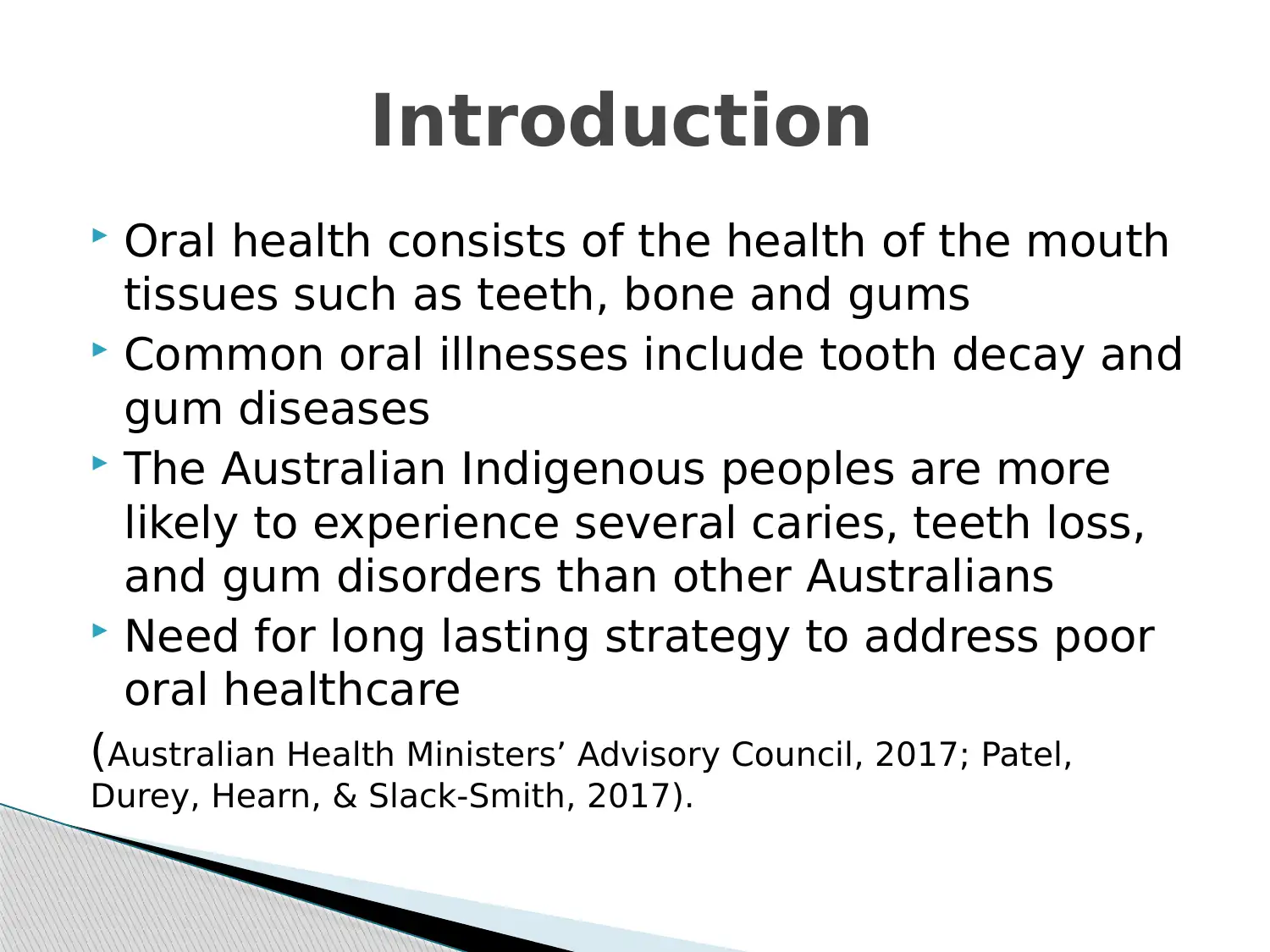
Oral health consists of the health of the mouth
tissues such as teeth, bone and gums
Common oral illnesses include tooth decay and
gum diseases
The Australian Indigenous peoples are more
likely to experience several caries, teeth loss,
and gum disorders than other Australians
Need for long lasting strategy to address poor
oral healthcare
(Australian Health Ministers’ Advisory Council, 2017; Patel,
Durey, Hearn, & Slack‐Smith, 2017).
Introduction
tissues such as teeth, bone and gums
Common oral illnesses include tooth decay and
gum diseases
The Australian Indigenous peoples are more
likely to experience several caries, teeth loss,
and gum disorders than other Australians
Need for long lasting strategy to address poor
oral healthcare
(Australian Health Ministers’ Advisory Council, 2017; Patel,
Durey, Hearn, & Slack‐Smith, 2017).
Introduction
⊘ This is a preview!⊘
Do you want full access?
Subscribe today to unlock all pages.

Trusted by 1+ million students worldwide
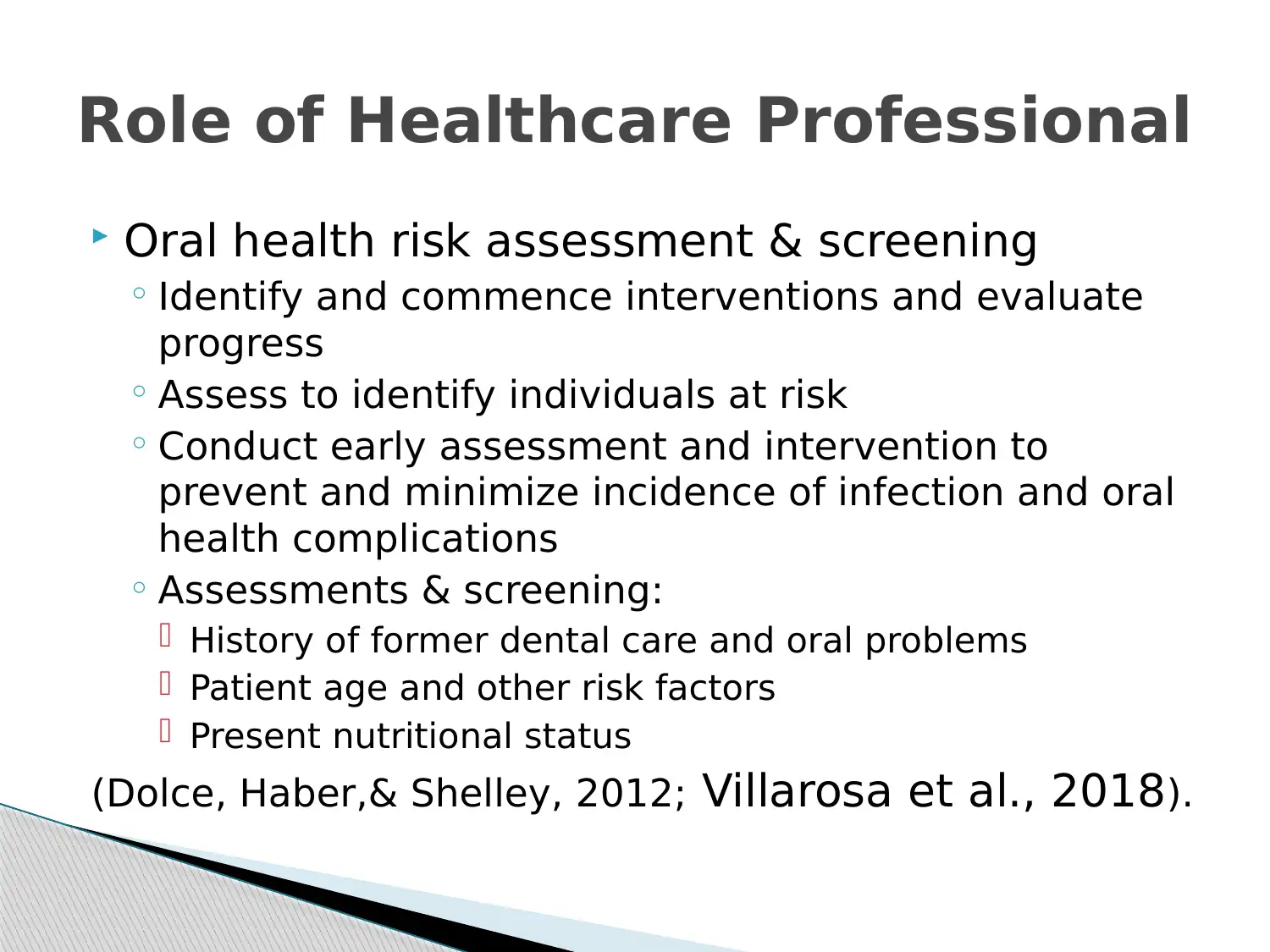
Oral health risk assessment & screening
◦ Identify and commence interventions and evaluate
progress
◦ Assess to identify individuals at risk
◦ Conduct early assessment and intervention to
prevent and minimize incidence of infection and oral
health complications
◦ Assessments & screening:
History of former dental care and oral problems
Patient age and other risk factors
Present nutritional status
(Dolce, Haber,& Shelley, 2012; Villarosa et al., 2018).
Role of Healthcare Professional
◦ Identify and commence interventions and evaluate
progress
◦ Assess to identify individuals at risk
◦ Conduct early assessment and intervention to
prevent and minimize incidence of infection and oral
health complications
◦ Assessments & screening:
History of former dental care and oral problems
Patient age and other risk factors
Present nutritional status
(Dolce, Haber,& Shelley, 2012; Villarosa et al., 2018).
Role of Healthcare Professional
Paraphrase This Document
Need a fresh take? Get an instant paraphrase of this document with our AI Paraphraser
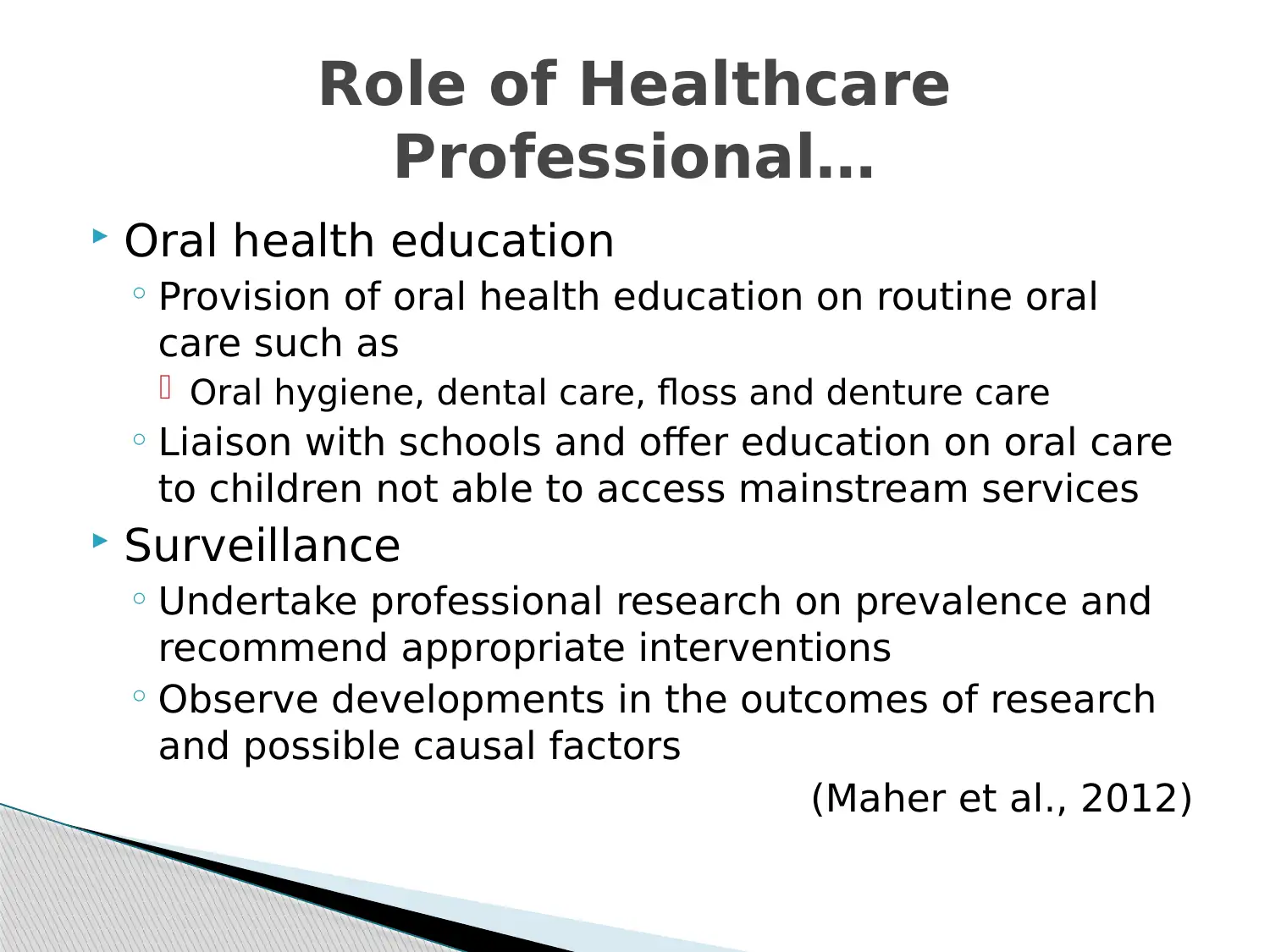
Oral health education
◦ Provision of oral health education on routine oral
care such as
Oral hygiene, dental care, floss and denture care
◦ Liaison with schools and offer education on oral care
to children not able to access mainstream services
Surveillance
◦ Undertake professional research on prevalence and
recommend appropriate interventions
◦ Observe developments in the outcomes of research
and possible causal factors
(Maher et al., 2012)
Role of Healthcare
Professional…
◦ Provision of oral health education on routine oral
care such as
Oral hygiene, dental care, floss and denture care
◦ Liaison with schools and offer education on oral care
to children not able to access mainstream services
Surveillance
◦ Undertake professional research on prevalence and
recommend appropriate interventions
◦ Observe developments in the outcomes of research
and possible causal factors
(Maher et al., 2012)
Role of Healthcare
Professional…
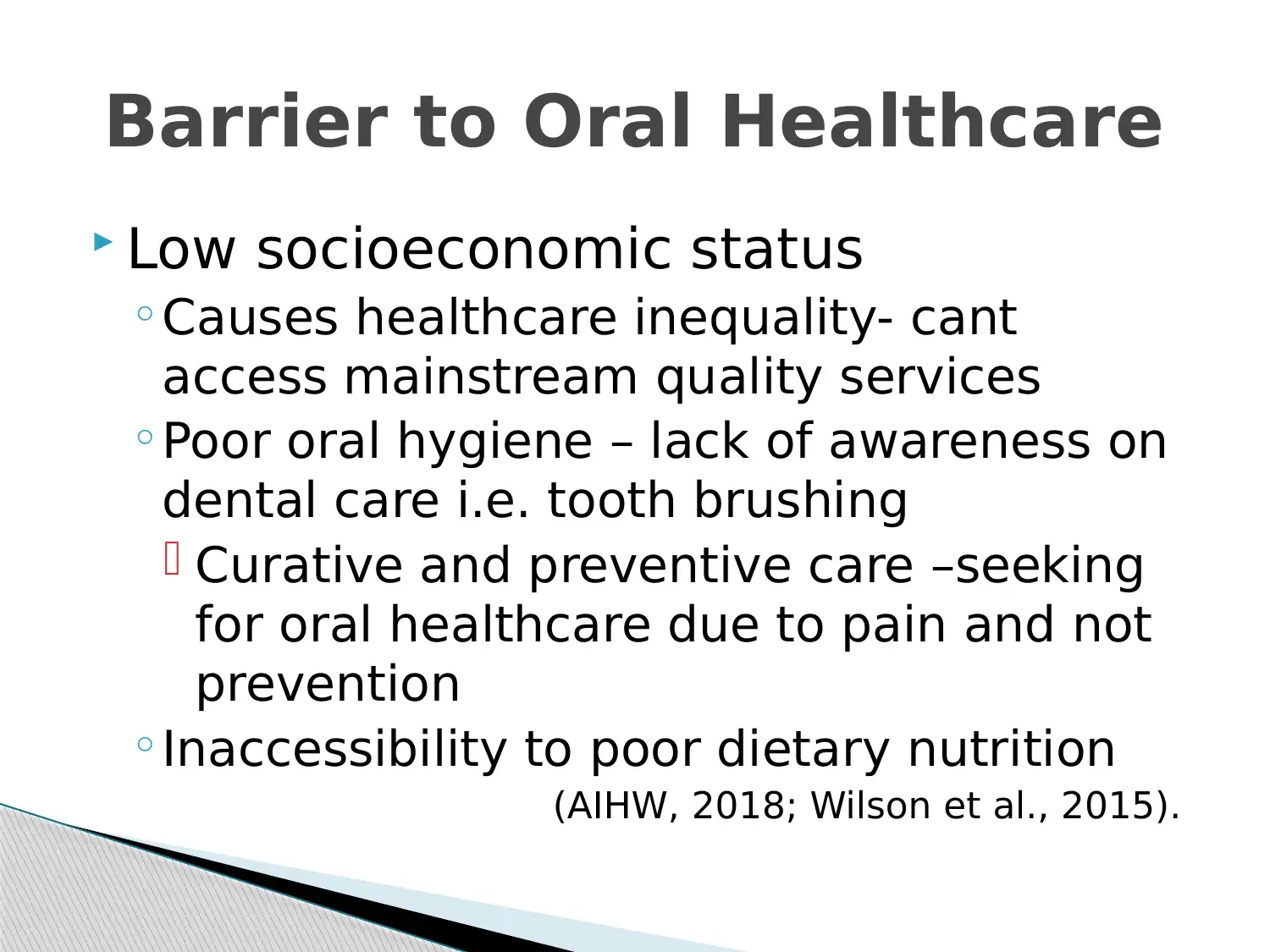
Low socioeconomic status
◦Causes healthcare inequality- cant
access mainstream quality services
◦Poor oral hygiene – lack of awareness on
dental care i.e. tooth brushing
Curative and preventive care –seeking
for oral healthcare due to pain and not
prevention
◦Inaccessibility to poor dietary nutrition
(AIHW, 2018; Wilson et al., 2015).
Barrier to Oral Healthcare
◦Causes healthcare inequality- cant
access mainstream quality services
◦Poor oral hygiene – lack of awareness on
dental care i.e. tooth brushing
Curative and preventive care –seeking
for oral healthcare due to pain and not
prevention
◦Inaccessibility to poor dietary nutrition
(AIHW, 2018; Wilson et al., 2015).
Barrier to Oral Healthcare
⊘ This is a preview!⊘
Do you want full access?
Subscribe today to unlock all pages.

Trusted by 1+ million students worldwide
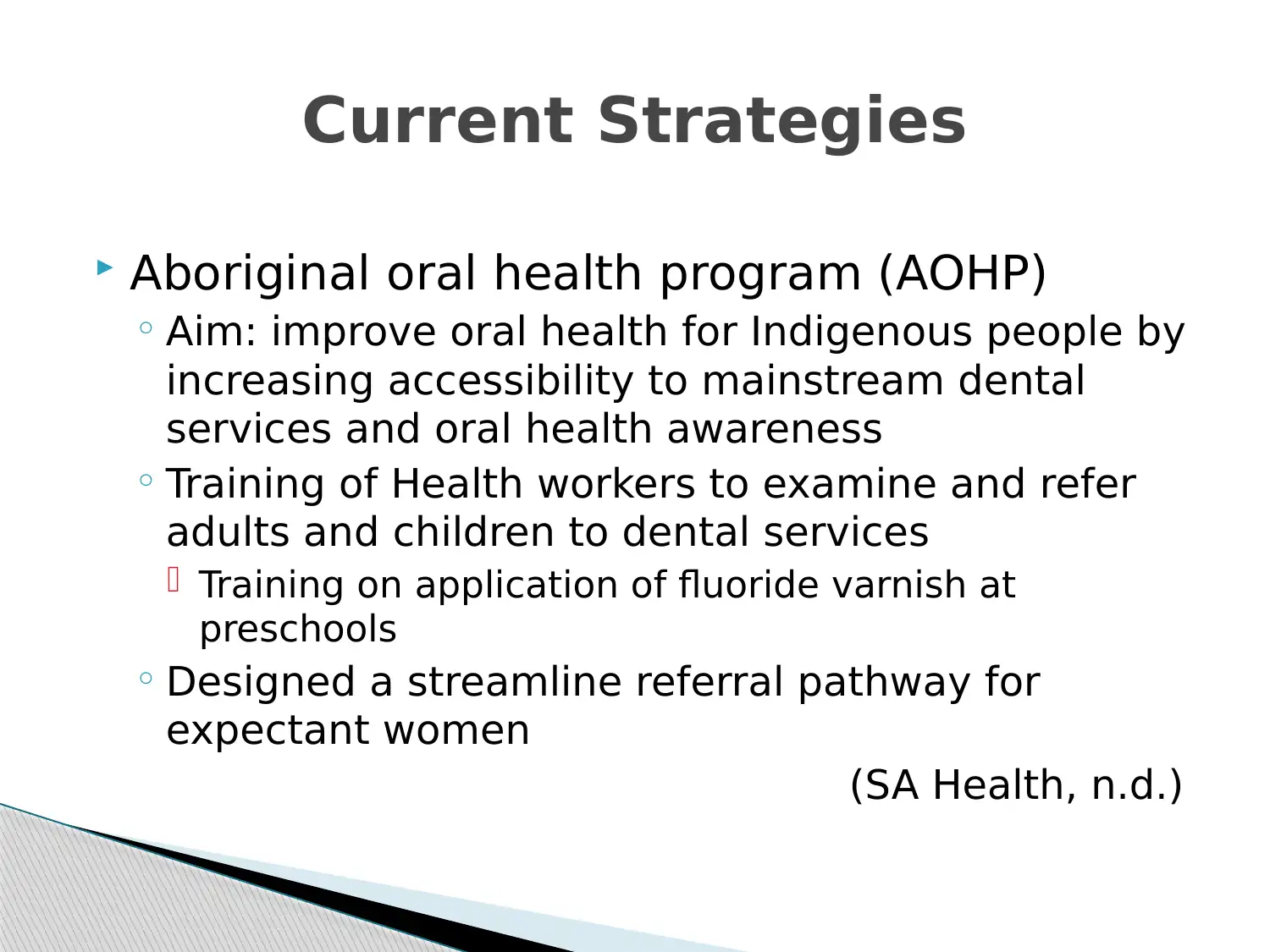
Aboriginal oral health program (AOHP)
◦ Aim: improve oral health for Indigenous people by
increasing accessibility to mainstream dental
services and oral health awareness
◦ Training of Health workers to examine and refer
adults and children to dental services
Training on application of fluoride varnish at
preschools
◦ Designed a streamline referral pathway for
expectant women
(SA Health, n.d.)
Current Strategies
◦ Aim: improve oral health for Indigenous people by
increasing accessibility to mainstream dental
services and oral health awareness
◦ Training of Health workers to examine and refer
adults and children to dental services
Training on application of fluoride varnish at
preschools
◦ Designed a streamline referral pathway for
expectant women
(SA Health, n.d.)
Current Strategies
Paraphrase This Document
Need a fresh take? Get an instant paraphrase of this document with our AI Paraphraser
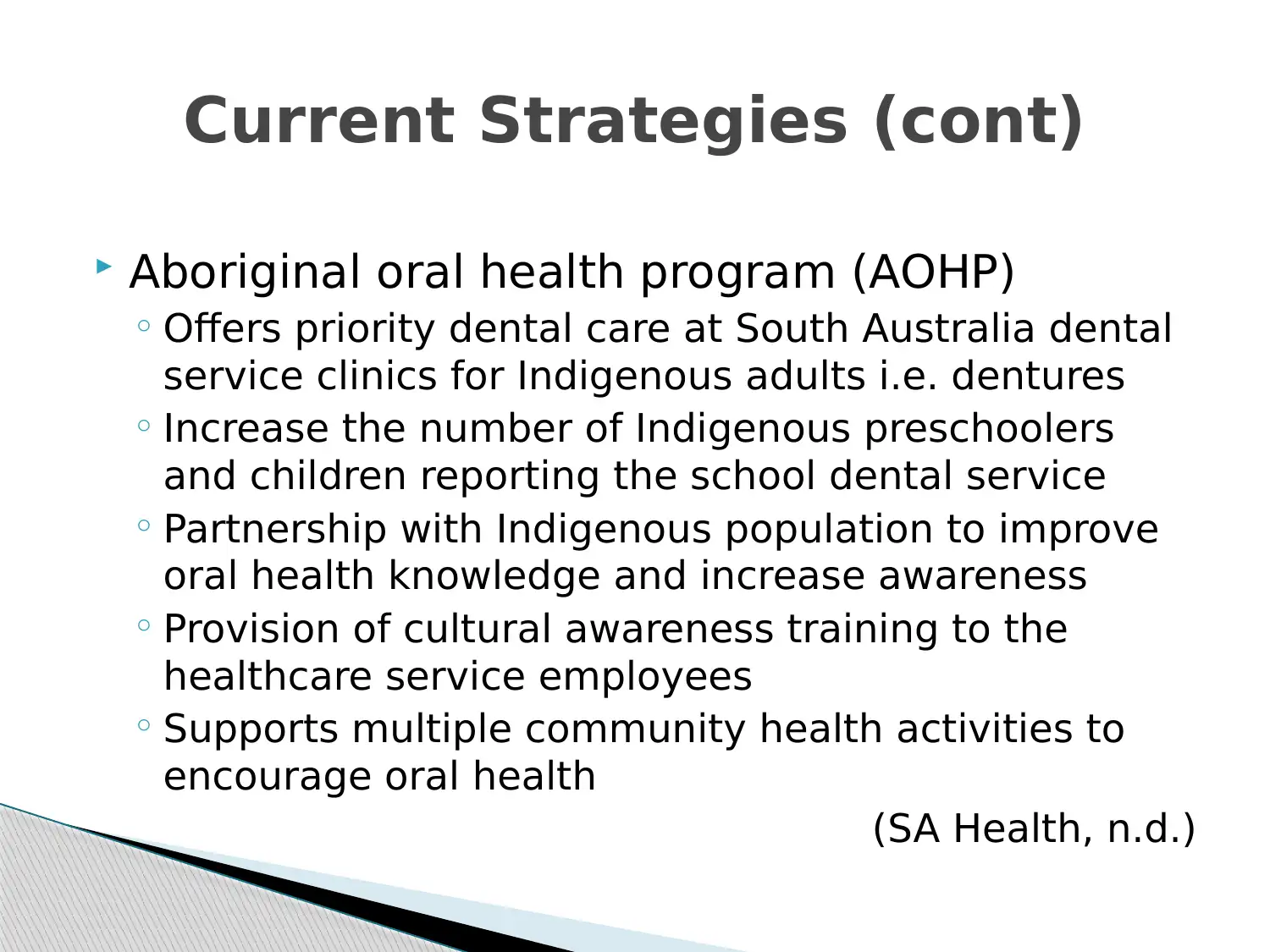
Aboriginal oral health program (AOHP)
◦ Offers priority dental care at South Australia dental
service clinics for Indigenous adults i.e. dentures
◦ Increase the number of Indigenous preschoolers
and children reporting the school dental service
◦ Partnership with Indigenous population to improve
oral health knowledge and increase awareness
◦ Provision of cultural awareness training to the
healthcare service employees
◦ Supports multiple community health activities to
encourage oral health
(SA Health, n.d.)
Current Strategies (cont)
◦ Offers priority dental care at South Australia dental
service clinics for Indigenous adults i.e. dentures
◦ Increase the number of Indigenous preschoolers
and children reporting the school dental service
◦ Partnership with Indigenous population to improve
oral health knowledge and increase awareness
◦ Provision of cultural awareness training to the
healthcare service employees
◦ Supports multiple community health activities to
encourage oral health
(SA Health, n.d.)
Current Strategies (cont)
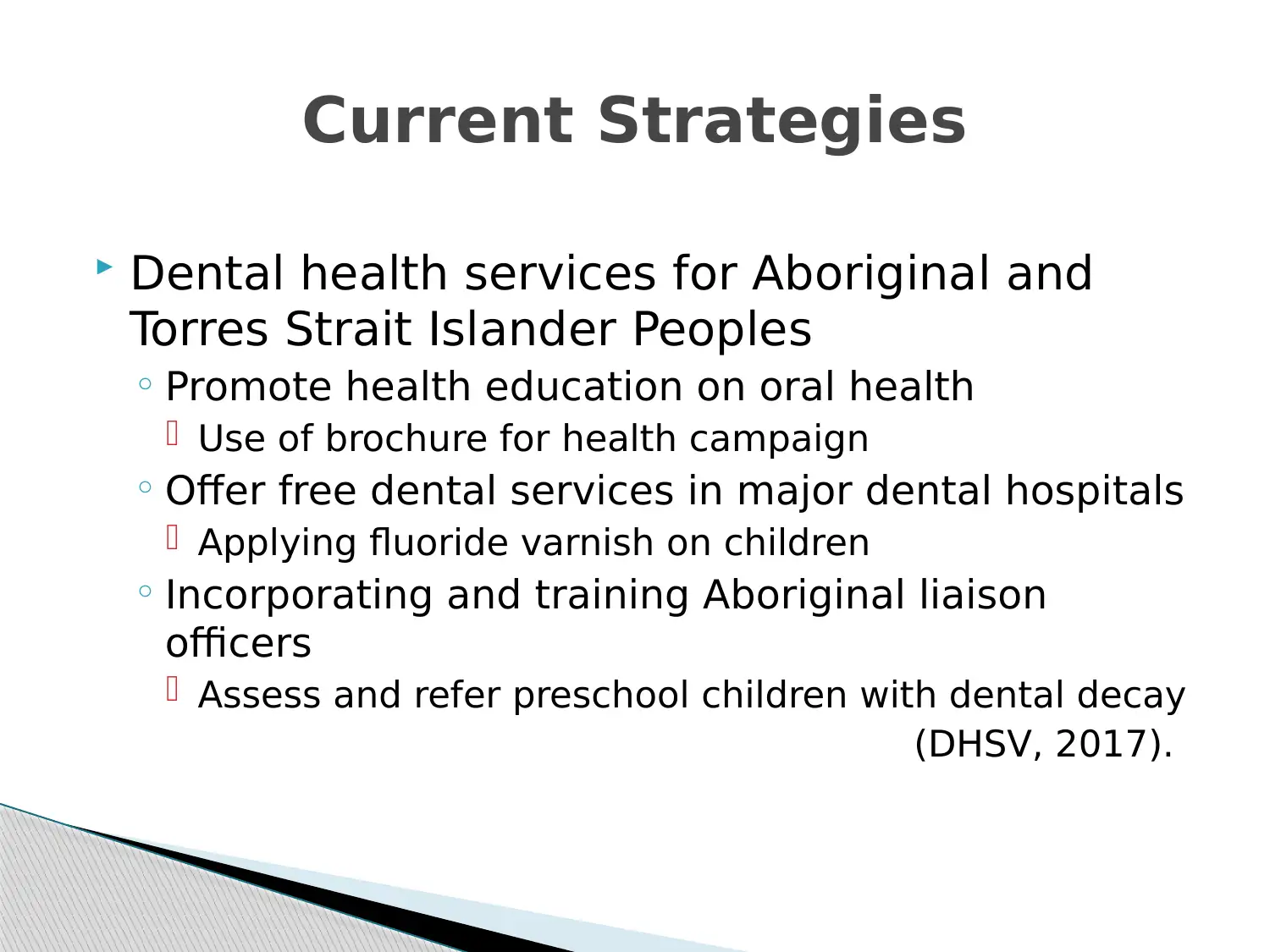
Dental health services for Aboriginal and
Torres Strait Islander Peoples
◦ Promote health education on oral health
Use of brochure for health campaign
◦ Offer free dental services in major dental hospitals
Applying fluoride varnish on children
◦ Incorporating and training Aboriginal liaison
officers
Assess and refer preschool children with dental decay
(DHSV, 2017).
Current Strategies
Torres Strait Islander Peoples
◦ Promote health education on oral health
Use of brochure for health campaign
◦ Offer free dental services in major dental hospitals
Applying fluoride varnish on children
◦ Incorporating and training Aboriginal liaison
officers
Assess and refer preschool children with dental decay
(DHSV, 2017).
Current Strategies
⊘ This is a preview!⊘
Do you want full access?
Subscribe today to unlock all pages.

Trusted by 1+ million students worldwide
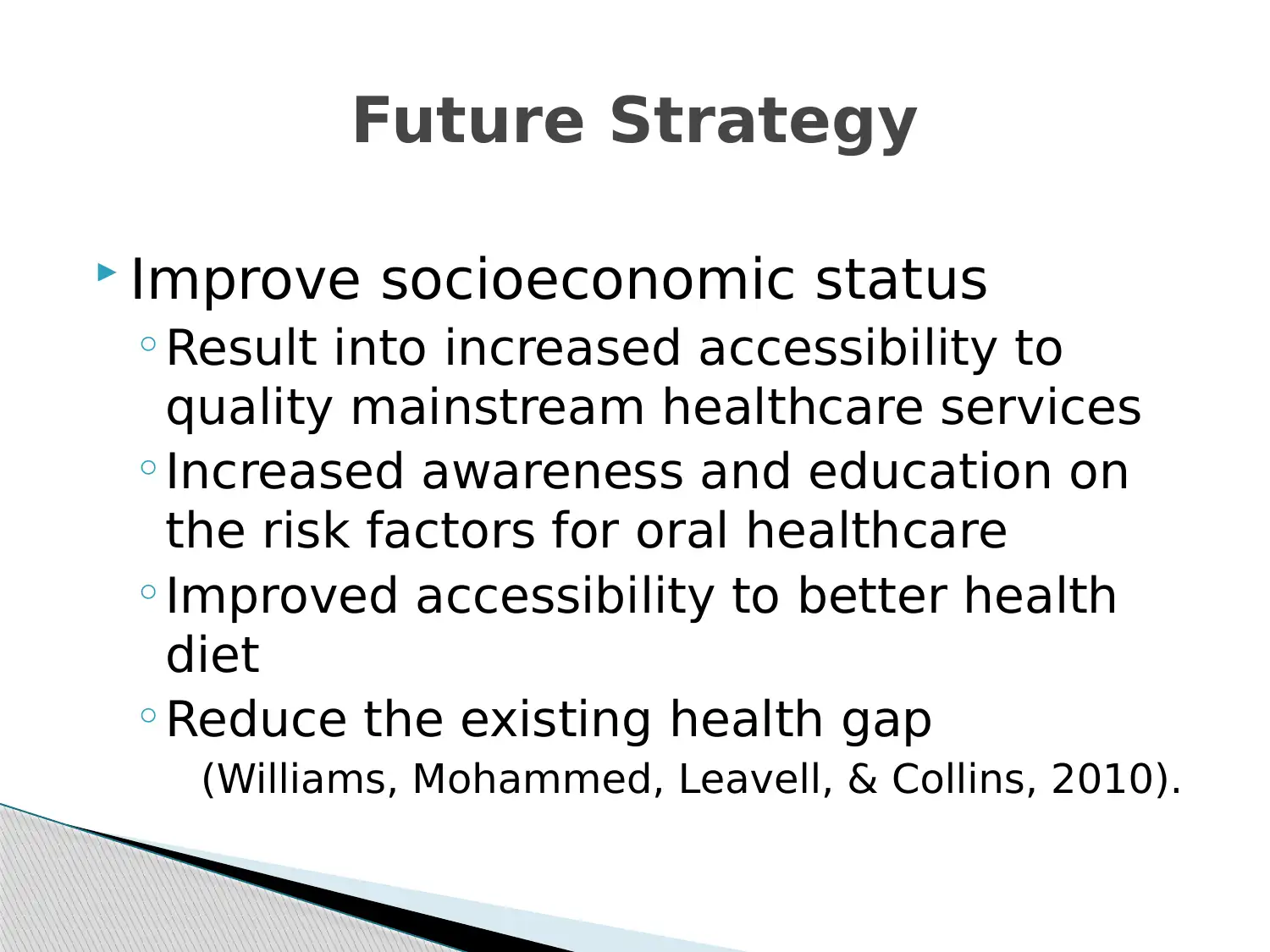
Improve socioeconomic status
◦Result into increased accessibility to
quality mainstream healthcare services
◦Increased awareness and education on
the risk factors for oral healthcare
◦Improved accessibility to better health
diet
◦Reduce the existing health gap
(Williams, Mohammed, Leavell, & Collins, 2010).
Future Strategy
◦Result into increased accessibility to
quality mainstream healthcare services
◦Increased awareness and education on
the risk factors for oral healthcare
◦Improved accessibility to better health
diet
◦Reduce the existing health gap
(Williams, Mohammed, Leavell, & Collins, 2010).
Future Strategy
Paraphrase This Document
Need a fresh take? Get an instant paraphrase of this document with our AI Paraphraser
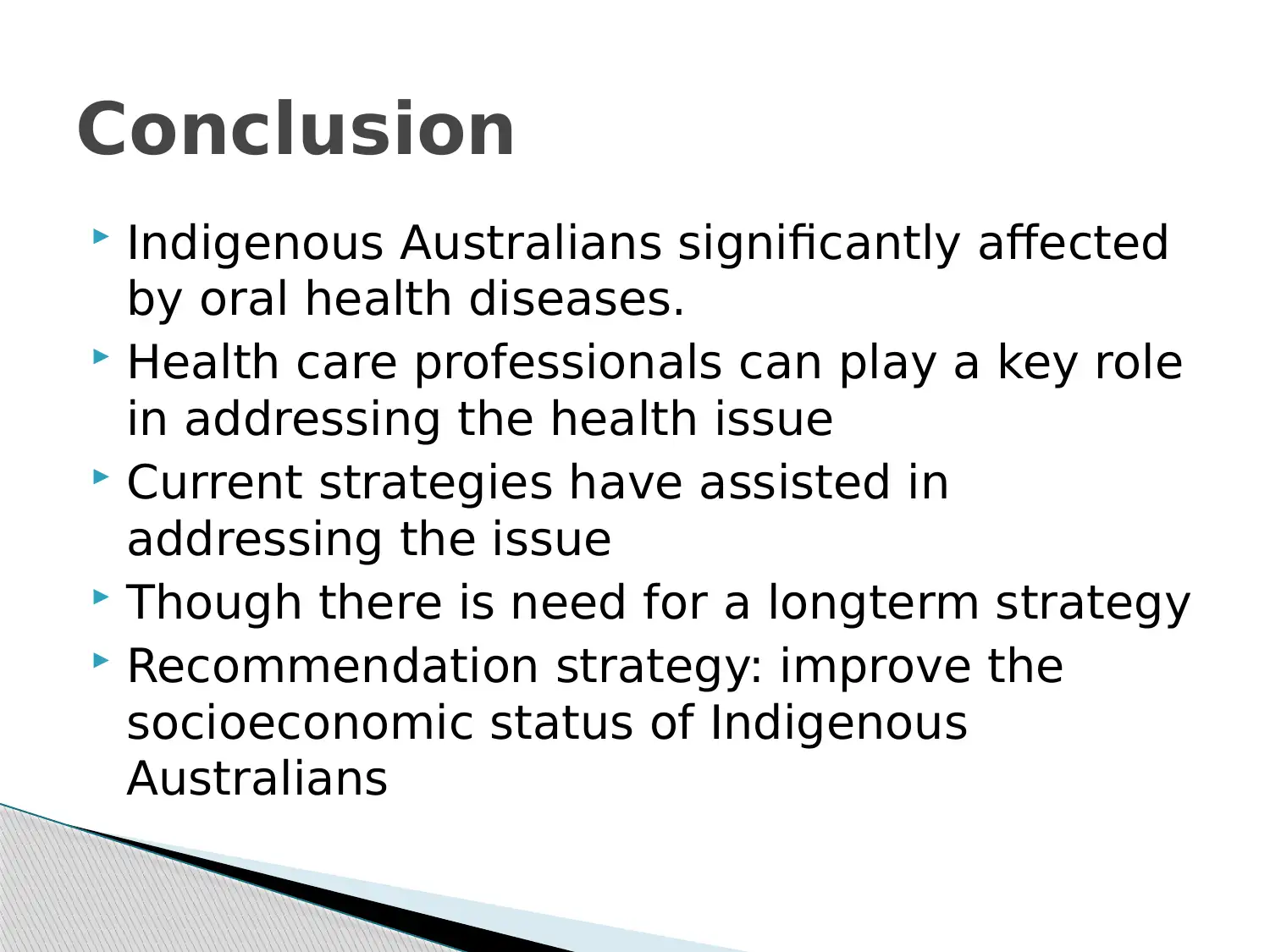
Indigenous Australians significantly affected
by oral health diseases.
Health care professionals can play a key role
in addressing the health issue
Current strategies have assisted in
addressing the issue
Though there is need for a longterm strategy
Recommendation strategy: improve the
socioeconomic status of Indigenous
Australians
Conclusion
by oral health diseases.
Health care professionals can play a key role
in addressing the health issue
Current strategies have assisted in
addressing the issue
Though there is need for a longterm strategy
Recommendation strategy: improve the
socioeconomic status of Indigenous
Australians
Conclusion
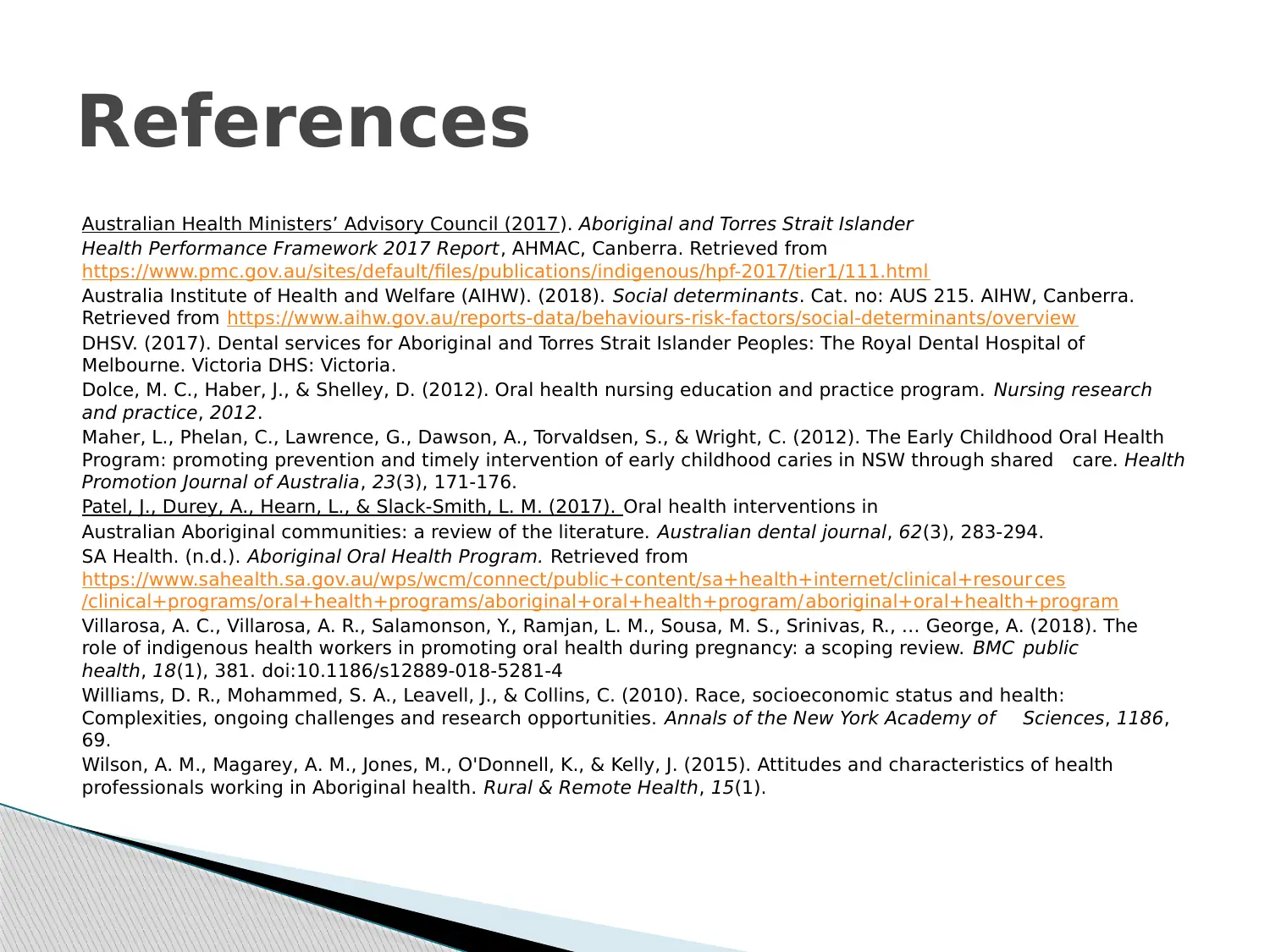
Australian Health Ministers’ Advisory Council (2017). Aboriginal and Torres Strait Islander
Health Performance Framework 2017 Report, AHMAC, Canberra. Retrieved from
https://www.pmc.gov.au/sites/default/files/publications/indigenous/hpf-2017/tier1/111.html
Australia Institute of Health and Welfare (AIHW). (2018). Social determinants. Cat. no: AUS 215. AIHW, Canberra.
Retrieved from https://www.aihw.gov.au/reports-data/behaviours-risk-factors/social-determinants/overview
DHSV. (2017). Dental services for Aboriginal and Torres Strait Islander Peoples: The Royal Dental Hospital of
Melbourne. Victoria DHS: Victoria.
Dolce, M. C., Haber, J., & Shelley, D. (2012). Oral health nursing education and practice program. Nursing research
and practice, 2012.
Maher, L., Phelan, C., Lawrence, G., Dawson, A., Torvaldsen, S., & Wright, C. (2012). The Early Childhood Oral Health
Program: promoting prevention and timely intervention of early childhood caries in NSW through shared care. Health
Promotion Journal of Australia, 23(3), 171-176.
Patel, J., Durey, A., Hearn, L., & Slack‐Smith, L. M. (2017). Oral health interventions in
Australian Aboriginal communities: a review of the literature. Australian dental journal, 62(3), 283-294.
SA Health. (n.d.). Aboriginal Oral Health Program. Retrieved from
https://www.sahealth.sa.gov.au/wps/wcm/connect/public+content/sa+health+internet/clinical+resour ces
/clinical+programs/oral+health+programs/aboriginal+oral+health+program/aboriginal+oral+health+program
Villarosa, A. C., Villarosa, A. R., Salamonson, Y., Ramjan, L. M., Sousa, M. S., Srinivas, R., … George, A. (2018). The
role of indigenous health workers in promoting oral health during pregnancy: a scoping review. BMC public
health, 18(1), 381. doi:10.1186/s12889-018-5281-4
Williams, D. R., Mohammed, S. A., Leavell, J., & Collins, C. (2010). Race, socioeconomic status and health:
Complexities, ongoing challenges and research opportunities. Annals of the New York Academy of Sciences, 1186,
69.
Wilson, A. M., Magarey, A. M., Jones, M., O'Donnell, K., & Kelly, J. (2015). Attitudes and characteristics of health
professionals working in Aboriginal health. Rural & Remote Health, 15(1).
References
Health Performance Framework 2017 Report, AHMAC, Canberra. Retrieved from
https://www.pmc.gov.au/sites/default/files/publications/indigenous/hpf-2017/tier1/111.html
Australia Institute of Health and Welfare (AIHW). (2018). Social determinants. Cat. no: AUS 215. AIHW, Canberra.
Retrieved from https://www.aihw.gov.au/reports-data/behaviours-risk-factors/social-determinants/overview
DHSV. (2017). Dental services for Aboriginal and Torres Strait Islander Peoples: The Royal Dental Hospital of
Melbourne. Victoria DHS: Victoria.
Dolce, M. C., Haber, J., & Shelley, D. (2012). Oral health nursing education and practice program. Nursing research
and practice, 2012.
Maher, L., Phelan, C., Lawrence, G., Dawson, A., Torvaldsen, S., & Wright, C. (2012). The Early Childhood Oral Health
Program: promoting prevention and timely intervention of early childhood caries in NSW through shared care. Health
Promotion Journal of Australia, 23(3), 171-176.
Patel, J., Durey, A., Hearn, L., & Slack‐Smith, L. M. (2017). Oral health interventions in
Australian Aboriginal communities: a review of the literature. Australian dental journal, 62(3), 283-294.
SA Health. (n.d.). Aboriginal Oral Health Program. Retrieved from
https://www.sahealth.sa.gov.au/wps/wcm/connect/public+content/sa+health+internet/clinical+resour ces
/clinical+programs/oral+health+programs/aboriginal+oral+health+program/aboriginal+oral+health+program
Villarosa, A. C., Villarosa, A. R., Salamonson, Y., Ramjan, L. M., Sousa, M. S., Srinivas, R., … George, A. (2018). The
role of indigenous health workers in promoting oral health during pregnancy: a scoping review. BMC public
health, 18(1), 381. doi:10.1186/s12889-018-5281-4
Williams, D. R., Mohammed, S. A., Leavell, J., & Collins, C. (2010). Race, socioeconomic status and health:
Complexities, ongoing challenges and research opportunities. Annals of the New York Academy of Sciences, 1186,
69.
Wilson, A. M., Magarey, A. M., Jones, M., O'Donnell, K., & Kelly, J. (2015). Attitudes and characteristics of health
professionals working in Aboriginal health. Rural & Remote Health, 15(1).
References
⊘ This is a preview!⊘
Do you want full access?
Subscribe today to unlock all pages.

Trusted by 1+ million students worldwide
1 out of 12
Related Documents
Your All-in-One AI-Powered Toolkit for Academic Success.
+13062052269
info@desklib.com
Available 24*7 on WhatsApp / Email
![[object Object]](/_next/static/media/star-bottom.7253800d.svg)
Unlock your academic potential
Copyright © 2020–2025 A2Z Services. All Rights Reserved. Developed and managed by ZUCOL.





